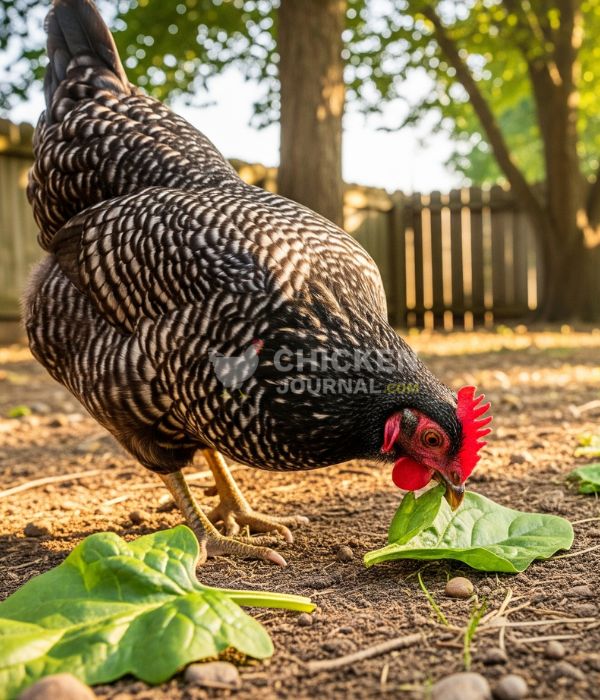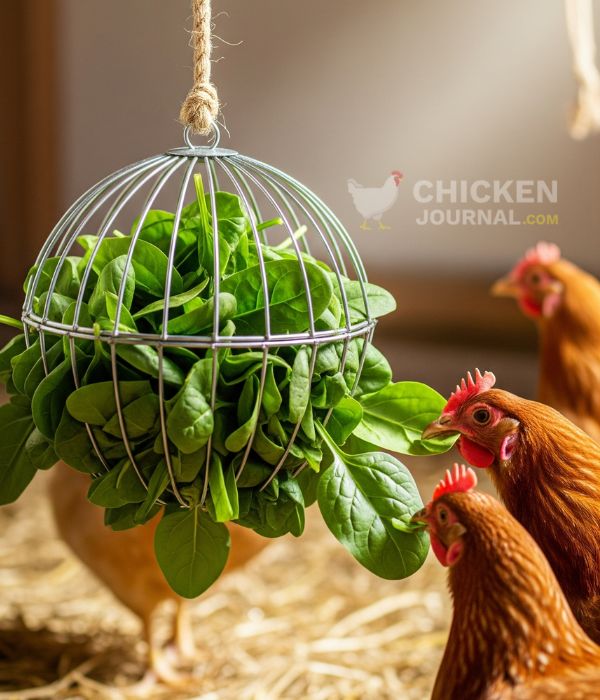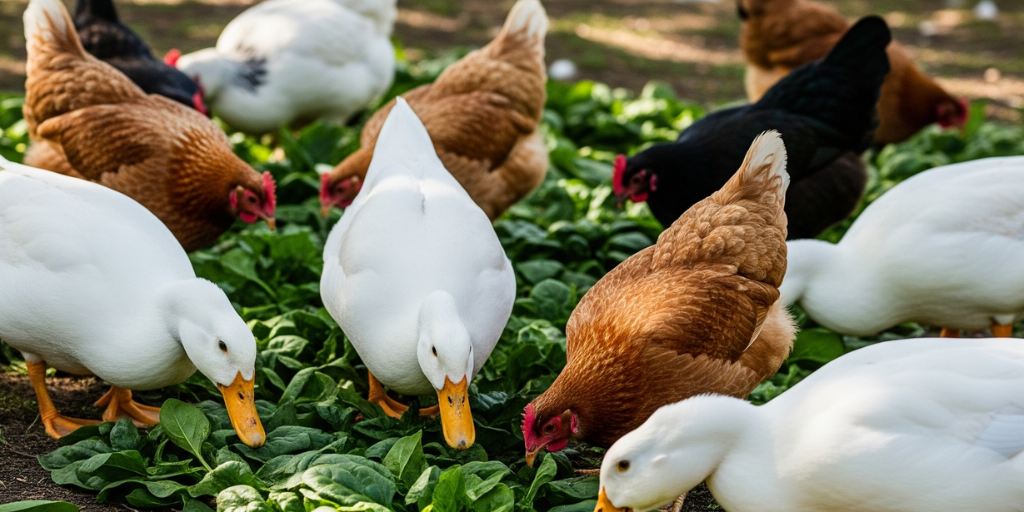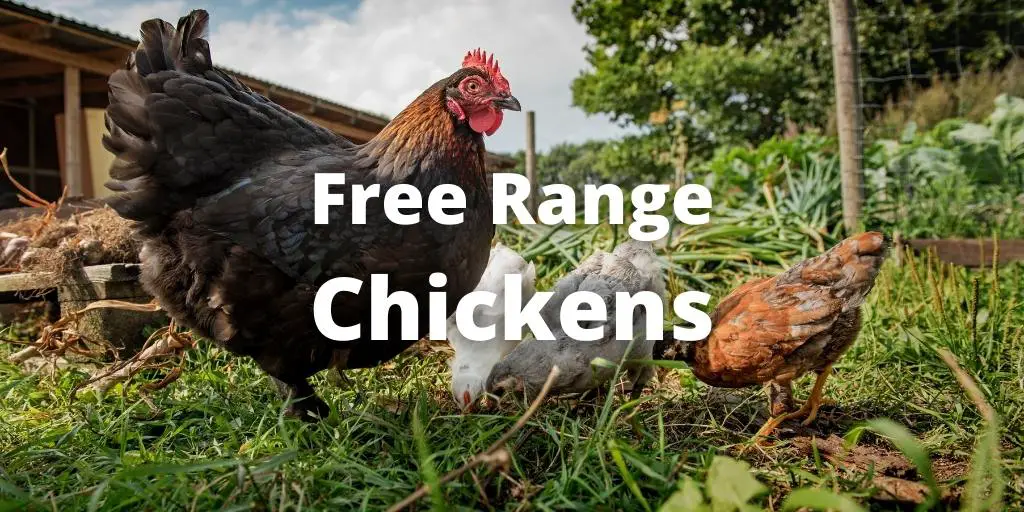Spinach is a nutrient-packed leafy green that you may have in your kitchen or garden. You might wonder: Can chickens and ducks eat spinach, and is it good for them?
The short answer is yes – both chickens and ducks can safely eat spinach in moderation.
In fact, spinach supplies vitamins (A, C, K, and B vitamins) and minerals (calcium, iron, and magnesium) that support your poultry’s health.
For example, spinach’s high vitamin K helps blood clotting, which prevents internal bleeding and blood spots in eggs. Also, calcium contributes to strong eggshells and bones.
However, you also need to to aware that spinach contains oxalic acid. Oxalates bind calcium and iron in the gut, which can reduce the mineral absorption percentage.
In high amounts, that could lead to soft or thin eggshells and even egg-binding. So, you can add spinach to your flock’s diet, but only as an occasional treat, not a daily staple.
Below is a detailed guide to feeding spinach safely to chickens and ducks. We cover nutrition, health benefits, risks, and practical recipe-style suggestions and FAQs.
As a poultry raiser, you’ll learn exactly how to give spinach and similar greens to keep chickens healthy and happy.
Nutritional Profile of Spinach
Spinach is a very nutritious green for both humans and animals. According to the USDA, 100g of raw spinach contains only about 28 calories but is rich in vitamins and minerals. Key nutrients include:
Vitamin A (as beta-carotene): This keeps poultry birds’ vision, skin/feathers, and immune function healthy. Spinach also contains beta-carotene.
Vitamin K: It is essential for blood clotting. Spinach has lots of vitamin K – more than four times the daily requirement for people, which helps prevent bleeding and blood spots in eggs.
Vitamin C & E: These antioxidants boost immunity in chickens. Spinach provides vitamin C (~30mg/100g), and vitamin E keeps flocks away from seasonal health issues.
B vitamins (folate, thiamin, riboflavin, niacin, B6, biotin): These B vitamins enhance metabolism and energy.
Minerals: Calcium (~67mg/100g) for bone/eggshell health, iron (about 1mg/100g) for blood, magnesium (~93mg/100g), potassium (460mg/100g) for heart function, plus phosphorus, zinc, copper, manganese, and iodine.
Fibre and Water: Spinach is ~91% water by weight, and it has some fibre to aid digestion.
Table: Sample Nutrients in Spinach (per 100g) – USDA Data
| Nutrient | Amount per 100g Spinach | Benefit for Poultry |
| Calories | 28 kcal | Low-calorie treat |
| Protein | 2.9 g | Supports muscle/feather growth |
| Calcium (Ca) | 67 mg | Healthy eggs, bones (though much bound by oxalates) |
| Iron (Fe) | 1.05 mg | Blood, oxygen transport |
| Vitamin A (RAE) | 306 µg | Vision, reproduction |
| Vitamin C | 30.3 mg | Immunity, antioxidant |
| Vitamin K | High (>> human RDA) | Blood clotting (reduces blood spots) |
| Fiber | 1.6 g | Gut motility |
These nutrients explain why spinach is sometimes called a “superfood.” For your chickens and ducks, the high levels of vitamin K and calcium can support strong eggshells and blood health.
The vitamin E in spinach is an antioxidant that helps fight disease and maintain the nervous system of your flock. B vitamins support metabolism and nutrient uptake.
Vitamin A promotes growth and good vision. In summary, spinach’s vitamin and mineral “scorecard” shows it can offer substantial health benefits when fed in the right amount.
Health Benefits for Chickens and Ducks

When you feed a little spinach to your poultry, they can enjoy several benefits:
Blood and Egg Health (Vitamin K): Vitamin K helps your flock clot blood normally. According to experts, the large vitamin K content in spinach “can help prevent internal hemorrhaging by improving blood clotting, and also prevents blood spots in eggs”. This means healthier laying hens and fewer blemishes in eggs.
Stronger Bones and Shells (Calcium): The calcium in spinach (67mg/100g) contributes to eggshell formation. Combined with vitamin K, this is an excellent benefit for laying hens and for a healthy skeleton overall. However, remember oxalates bind some of that calcium, so spinach’s calcium may not be fully absorbed.
Immune Support (Vitamin E & C): Spinach’s antioxidants (like vitamin E and C) help immune function. Free-range birds that forage on plants often have strong immunity. When you supplement with spinach, you give them extra disease-fighting nutrients.
Feather and Skin Health (Vitamin A, Carotenoids): The high vitamin A or beta-carotene content promotes feather growth and healthy skin. It’s also suitable for vision and reproduction.
General Nutrition and Hydration: Spinach is ~91% water, so it provides moisture (especially useful in summer). Its fiber and bulk can aid digestion as a treat, keeping the gut moving.
In practice, many keepers note that both chickens and ducks like the taste of green spinach. Spinach and other leafy vegetables can make your flock excited at mealtime.
For example, Lisa Steele of Fresh Eggs Daily writes that “ducks love spinach, as do chickens” (especially floating it in their water).
The baby chicks chow down on greens like spinach easily once introduced. In short, when offered, your birds will usually eat spinach leaves enthusiastically – treat it like a “salad” snack for them.
Oxalic Acid and Eggshell Issues (Risks): While spinach is nutritious, it also contains oxalic acid (oxalates) – the main reason to feed it cautiously. Oxalic acid binds to calcium and iron in the digestive tract, forming calcium oxalate. This means:
Reduced Calcium Absorption:
The calcium in spinach largely becomes tied up by oxalates, so it’s not absorbable. Importantly, oxalates only bind to the calcium present in the same food.
If your bird eats other calcium sources (like oyster shell or scratch grains) in the same meal, those can still be absorbed.
Oxalic acid will only suppress the absorption of calcium from food that contains oxalic acid.
It does not affect the calcium in other foods, even when eaten in the same meal. So you can say, spinach’s own calcium is largely unavailable, but calcium from a separate supplement or feed can still be used.
Eggshell Problems:
Eggshells are almost all calcium. If too much calcium from any source is tied up, a laying hen or duck can lay eggs with thin or soft shells.
Too much spinach will likely result in thin or even entirely absent eggshells. This is because insufficient calcium reaches the blood for shell production.
Egg Binding:
Another risk of soft shells is egg binding. If an egg has little or no shell, it can get stuck inside the bird.
Eating spinach in large amounts or often can hinder calcium absorption and cause your ducks to have very little or no shells on their eggs.
If a duck has little or no shell on their eggs, they gets stuck inside, usually resulting in death. That’s a serious risk, underscoring why spinach should only be a rare treat for layers.
Other Minerals:
Oxalates can also chelate (bind) other minerals like zinc and iron. As spinach contains a high amount of oxalic acid, which binds calcium, magnesium, zinc, and iron in both the feed and the bloodstream, making it unusable for your chickens.
In humans, high oxalate diets are linked to kidney stones, and some suggest it may have subclinical effects in chickens, too. So, we can say spinach has more downsides than other common greens.
However, keep in mind that if your chickens/ducks have a balanced and healthy diet, the oxalic acid in an occasional spinach treat does not cause a lack of nutrients.
Feeding Spinach Safely: Tips & Recipes

To feed spinach without problems, follow these guidelines:
Serve as a Treat (10% Rule):
Treats (fruits/veggies, kitchen scraps) should be no more than 10% of your chickens or ducks’ diet. That means for each bird, you might give only a few ounces of treats per week.
Spinach is totally edible to chickens, but it is a treat. Treats should not be more than 10% of a chicken’s diet.
It comes down to a few teaspoons per chicken, which is not a lot at all. In practice, offer spinach once or twice a week, not daily.
Chop or Tear Leaves:
Chickens and ducks prefer smaller bites. Tear large leaves or mix chopped spinach into other treats so they can easily peck it.
Setting out a bunch of leaves or heads and letting chickens peck at them to their heart’s content, as chickens will tear the leaves themselves.
You can also hang spinach leaves or place them on the coop floor as a scratch. You can hang the spinach leaves using a thin rope or inside a chicken hanging toy.
Raw or Cooked:
You can give spinach to chickens/ducks raw or cooked. Raw spinach has its full complement of nutrients, and most chickens/ducks will eat it readily once they acclimatize to it.
If you cook it, it will be more tender (easier to consume), and less nutritious, and it will shrink some to lower the volume! Either way, it works!
Mixing with Other Foods:
You can combine with other greens (kale, lettuce, parsley) and allowable vegetables (peas, grated carrot) to offset the oxalate impact.
You can add spinach to fermented mash or layer it below other treats or toss spinach in as a surprise treat in fermented grower mash.
When making a “balanced feed” into a treat (aka not a whole diet i.e. fermented mash you can add “greens like arugula or spinach” without guilt because the main feed is still balanced.
Optional Use of Apple Cider Vinegar:
We add a bit of apple cider vinegar (ACV) to the birds’ drinking water when serving spinach.
The idea is that the extra acid (acetic acid), may help dissolve some mineral oxalates and improve nutrient uptake.
We find giving spinach and apple cider vinegar in water on the same day lets us “toss my chickens and ducks some spinach… in moderate amounts” with less concern.
However, still be careful with apple cider vinegar (1 tablespoon per gallon is safe) and not continuously.
Some apple cider vinegar over a period can weaken the gut lining and lower calcium uptake.
In practice, if you ever give apple cider vinegar for general health, it may also assist when you are giving high-oxalate greens like spinach.
Feed Floaters to Ducks:
Ducks like to forage in the water. A fun trick is to float chopped spinach in a tub or kiddy pool; ducks love to chase and nibble.
The ducks will also wash or rinse the leaves a bit too! Just change the water often to keep it from spoiling.
Extra Spinach Uses: Excess spinach can be frozen, pureed in baby food, or composted! An easy recipe: “Spinach Salad”. Shred spinach thinly, mix with a small amount of other greens or grains, and offer in dish or scatter on the ground. Unless it is a large portion, no special preparation is necessary. Just portion limit.
Freshness: on’t forget to wash any spinach well to get rid of pesticides or dirt and always remember to discard, as with any treat, if they start to look slimy or moldy.
By following these basic guidelines, you will be able to present spinach to your flock safely!
Spinach for Baby Chicks and Ducklings
Young birds have sensitive digestive systems, so you should be extra careful with spinach:
Take Your Time: Star soaking them in greens like spinach until they are 3-4 weeks old. When they are young, they should be on chick starter feed or a starter/grower pellet.
Start Small: Start with very small samples each week (just a few leaves or bites). The digestive tracts of the baby birds are delicate, and significant changes to their diet can cause crop issues or diarrhea.
Supply the Grit: If you are going to allow your ducks or chicks to eat vegetables, provide a dish of fine grit. Grit is necessary to grind fibrous foods like spinach in the gizzard. They need to have a little grit in their belly before eating anything other than crumbles.
In Case of Emergencies: You should be watching the small birds for any digestive distress. One common warning is that chicks/ducklings can be at risk of crop distress (serious) or diarrhea when they eat new leafy foods. If you see any evidence of these conditions (soft droppings, lethargy) stop the spinach treats.
On a positive note: Many people are able to feed leafy greens to growing ducks and chicks as part of their diet. Ducklings love asparagus and Brussels sprouts, and they love to pull lettuce and herb leaves apart. chickens should keep spinach as an occasional treat, not a staple of their diet.
Spinach for Laying vs Non-Laying Birds

Whether your birds are layers or meat/pets can affect how cautious you need to be:
Laying Hens & Ducks:
Birds that are laying will require calcium every day. If you are feeding spinach on a regular basis (i.e spinach is a common part of their daily diet), you may not be allowing them to sufficiently absorb enough calcium to form eggshells.
It is best to keep spinach as an occasional treat, once or twice a week at max (meaning tell the kids that they can only have it for a snack now and then!), and make sure to have a visible reliable source of calcium (let’s say oyster shell grit?) for them.
Here’s a thought: give them spinach on the same day they also have calcium supplements (e.g, whatever you added extra to the oyster shell or you stuck into their ACV water) to cancel out its oxalate properties.
Non-Layers (Meat/Ducks or Roosters):
If the bird is not physically producing eggs (i.e, meat birds, roosters or pet ducks), then not having a shells is not a problem.
You’re free to give spinach as frequently as you like (in moderation of course). No chance of soft shells in this case. However, it is worth mentioning that oxalates may still bind to some minerals like iron and magnesium.
So if you are not dealing with laying birds on a regular basis, and you have confirmed that the bird’s diet is as varied and well-rounded as it can get, then there is really nothing at all to be said about oxalic acid content. So having the non-layer birds have a couple of treats of spinach here and there is not an issue.
Older Birds:
Age is another factor. The high-producing (Cornish chickens or show layers) breeds are assumed to be more sensitive to being fed an unbalanced diet. Conversely, rugged traditional breed birds have more capacity to tolerate eating leftover scraps.
If you’re trying to feed a mixed chicken flock, both heritage birds and modern birds, once again every bird must be observed closely, especially if we are feeding high producing birds.
Again observe the birds. If you find a [consumer of the spinach] layer starts laying, what we think, are soft eggs after one week of eating spinach, you can either reduce the spinach, or discontinue the spinach completely.
A week of spinach feed only contributed to what we think was a thin shelled egg, and they did not feed more than that week to be safe. This kind of close monitoring means it’s wise to have collars on.
Kale and Other Leafy Alternatives
If you are looking for a greener alternative for feeding your birds, kale and other greens are much better options compared to spinach. Kale has almost no oxalic acid, which binds calcium.
Kale is a rich source of vitamins A, C, and K, and minerals and is safe for birds to eat. In fact, kale can be one of the 10% treats as long as it is washed and given in moderation.
Kale/collards/chard also has nutrients to offer without the oxalate issue.
For instance, in an article about chickens, kale was listed as “one of the most nutritious vegetables for chickens” that can be offered freely (still treats).
Other greens, such as romaine lettuce, Swiss chard, and dandelion leaves are treated as treats around chickens and ducks.
What to Do with Too Much Spinach
If you have homegrown or store-bought excess spinach, don’t throw it away! Here are some suggestions:
Freeze it to Use Later: Chop any excess spinach and freeze it in little bags. Then when you need some, defrost a bit and mix it with feed (a quick warm up won’t hurt). This way, you are using your spinach bit by bit, even so it doesn’t get spoiled.
Compost it: If you are about to spoil spinach, compost it (unless you used a heap of chemicals on it). It will make your compost pile better.
Feed Small Amounts: Don’t feed a ton of spinach at once. Split a large amount into small amounts per day. One large bunch of spinach may be too much for one day, but split to the eat over a couple of weeks, it will be OK.
Make Veggie Patties or Soups: As a treat for rabbits; you can mix some chopped spinach with any other veggies, namely peas, carrot, zucchini, etc. Use rice or oats; cooked, as a binder to make veggie patties or veggie mash. Just remember, you aren’t feeding them spice!
Share with Other Animals: Most other herbivores animals, i.e., goats and rabbits, will also eat spinach safely.
When feeding chickens spinach, mostly in moderation is good; just as that one keeper said, spinach can inhibit calcium absorption, so moderation is your friend.
Apple Cider Vinegar (ACV) and Poultry Birds
Some flock owners use ACV regularly in water (usually 0.5-1 tablespoon per gallon) as a general health tonic. Although there are many benefits reported with ACV use, including improved gut health, clearer water (less algae), and supportive of immune function.
AVC could be added when feeding spinach to develop acid levels and enhance calcium absorption.
Veterinarians warn that vinegar can leach calcium from feed or even injure the gut lining (at too high a concentration).
A few papers were found advising not to acidify water during hot weather or when birds have the highest needs for calcium (like heat stressed layers), if you are using ACV you could consider using it as an occasional supplement (1 tsp per gallon a few times per week).
Spinach can be beneficial for chickens in appropriate doses but not unlimited doses. Balanced nutrition and the occasional use of apple cider vinegar is important for the health of your flock.
Frequently Asked Questions (FAQ)
Q: Can chickens and ducks eat raw spinach?
A: Yes. In fact, the darker green uncooked spinach is more beneficial as it retains all the nutrition when fresh. If you sprinkle the washed leaves out, birds will peck at them. You can also steam or boil it lightly, warming it reduces volume and although some nutrient loss occurs, it will soften the spinach. Both raw and cooked spinach is fine, but cooked will not give you as much vitamin content.
Q: Do my birds actually like spinach?
A: Many do, if given the opportunity. Ducks particularly enjoy leafy greens and will consume spinach without hesitation. Chickens will vary, as some enjoy immediately consuming it while others may nibble slowly on it. Mixing the spinach with other foods that they prefer may help entice them to try it. If they don’t eat it the first time, try again in a few days. Eventually, they will begin to recognize it as a treat.
Q: How much spinach can I feed at once?
A: Keep it to a couple leaves or handfuls per bird per feeding; and it should be less than 10% of diet, at most. For example, for 5 chickens, a half-cup of chopped spinach split with all them, is more than enough. A half cup of spinach is far too much for them to think you are providing them treats; it still matters so be careful dumping a whole salad bowl into the run to pick through. Think of spinach as a garnish, like on a salad, not an entree.
Q: Can baby chicks or ducklings eat spinach?
A: They can, but wait until they are 3-4 weeks and eating a starter feed well. Start by giving them tiny amounts, very young chicks have immature crops and immature gizzards; giving them too many fibrous greens will cause sour crop, or diarrhea. Give them some pea-sized bits and see how they take it. Always offer grit.
Q: Will spinach make my chickens lay soft-shelled eggs?
A: Possibly – if given to excess. Spinach contains oxalic acid in it that can inhibit calcium absorption thus leading to having soft or shell-less eggs. This effect has mostly been produced by feeding a lot of spinach, or feeding spinach regularly. To prevent these problems offer spinach infrequently (like once or twice a week) and provide the layer feeds and oyster shell where chickens can always eat it. If you see soft eggs, or soft and shell-less eggs then reduce the spinach treatment.
Q: Can ducks eat spinach leaves and stems?
A: Yes, ducks are able to eat the leaves (and stems too) of spinach, but they are also only able to eat it in moderation like chickens are. Ducks love greens — one way to feed them greens is to toss spinach into a tub of water or to let them graze on grass in your lawn. Just know this: as one duck keeper has cautioned me — “spinach can decrease the amount of calcium that is absorbed by ducks, so limit their servings.” I suggest that the spinach is fed in extremely small quantities. While ducks are laying, take out the spinach – in other words, do not feed spinach when laying, or offer very small amounts when ducks are not laying.
Q: What about ducklings – is spinach safe for them?
A: Similar to chicks: after a couple of weeks of intake of starter feed, and introduce small amounts. You can start with a small spinach leaf, or a few leaves once per week. Like chickens, provide grit, and see how they respond.
Q: Can my chickens have spinach every day?
A: No. Not every day. This time the issue is a potential mineral nutrient imbalance. Keep the spinach as an occasional treat. Even with ACV, it is still possible that daily access to high-oxalate greens could chelate minerals (nutrients). A good rule to follow would be to change the treats up. For instance, provide spinach one day, then offer lettuce or cucumber the next day; later, somewhere in the week, you could possibly provide them mealworms as a treat. This way you are avoiding and/or limiting “overdosing” in regard to one compound.
Q: Are there safer substitutes for spinach?
A: Yes, kale, collard greens, Swiss chard, romaine lettuce, parsley, as well as some herbs are all leafy greens that are fine. These provide vitamins and fiber (without the oxalic acid issue, despite the chard having oxalates as well). Kale, for example, is even considered to be one of the top chicken veggies, and can be fed to hens in non-limited amounts as a treat. Also, mix the greens up and keep the flock happy and healthy.
Q: Can I feed spinach stems or only leaves?
A: Both are edible. Chickens and ducks will eat spinach stems, particularly smaller stems made from spinach, as very thick stems may be tougher than they can eat. Many keepers will cut large stems into smaller sizes or just briefly cook them. Note that the stems will have some nutrients, so no worry about feeding them – just chop them or tear them into bite-sized pieces.
Q: What about too much spinach – how do I handle leftovers?
A: If you have too much spinach (like from an overabundant garden or too good of a store deal), you can put them in the freezer, you can compost them, or you can feed little amounts over a few days. For example you could freeze the spinach, then thaw out a few tablespoons at a time to mix into their feed. Just don’t give it all at once – and consider that you could also use a rotation of treats (spinach one day, then kale or peas on a different day), which can make the most of your greens, while not over-loading.
Q: Can I give spinach on the same day as oyster shells or grit?
A: Yes! In fact, offering calcium supplements (like oyster shell) on the same day as giving spinach can help decrease the oxalate’s effect. Ducks tend to be offered oyster shell free-choice, so if you’re giving a little extra on a day where they will have spinach, it would be a logical thing to do. The timing is not that important (birds can eat calcium at any time), but it’s the earthy way to ensure they always have an easy access calcium source!
Q: Can chickens and ducks have apple cider vinegar (ACV)?
A: Sure, sometimes people will include ACV in poultry water. A lot of flock owners offer ~1 tablespoon per gallon of unfiltered ACV a few times a week as a supplement. It may help with waterborne bacteria and help with gut health. One thing to keep in mind: don’t use it when birds are being treated with specific antibiotics, when it is really hot (because it may reduce water intake or calcium uptake), or in large amounts. One good suggestion is to offer it on spinach days, but again, only in small amounts as a general tonic.
Conclusion
Spinach may be a good snack for your backyard chickens and ducks due to its high vitamin and mineral content. Using spinach once in while will boost their diets with added nutrients that support their eggs, feathers, and health.
But, since spinach contains high amounts of oxalic acid, it is important to use caution when feeding spinach to your flock.
Only feed spinach in small amounts, not every day, provide external calcium sources, and monitor the flock for potential problems such as thin-shelled eggs.
When fed properly, spinach is good, nutritious supplement to a diverse poultry diet.
Finally, remember to vary their diet. In conjunction with spinach, vary the greens (kale, herbs, lettuce) and other treats to keep your birds are being given a balanced snack menu.
By using the 10% treat rule and using these feeding guidelines, your flock can be happy, healthy, and ready for “spinach salad” treats.


